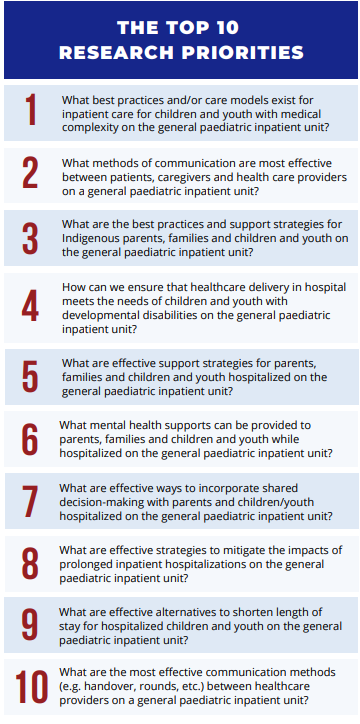Pediatric research hand in hand with families
For children and their families, a stay in hospital during childhood is extremely stressful. From worrying about whether the child will be okay, to family disruption and a loss of control, hospitalization can be a life-changing event.

A new network focused specifically on the pediatric in-patient hospital experience wants to alleviate some of that stress. The Canadian Paediatric Inpatient Research Network (PIRN) is a network of 19 health care institutions from coast to coast that aims to generate research evidence to improve the care and health of hospitalized children, in partnership with families and patients. Led by Drs. Sanjay Mahant and Peter Gill, pediatricians at the Hospital for Sick Children (SickKids), the network includes health care professionals from all children’s hospitals in Canada as well as community hospitals in Ontario where most children receive care.
“Nurses, occupational therapists, physicians, researchers, patient partners and others are part of the group – we’ve never had a well-organized way of working across Canada before this,” said Dr. Mahant. “What’s exciting is bringing together all these groups across the country with the goal of improving outcomes for children and their families.”
The network is definitely the offspring of OSSU and the larger SPOR initiative: the Ontario Child Health Support Unit (OCHSU), an OSSU research centre, funded the inaugural meeting, grants CIHR helped with priority-setting and from the OSSU EMPOWER program to move things to the next stage.
“I think the spirt of PIRN and our research is very much aligned with OSSU and its patient-oriented research work,” said Dr. Peter Gill, vice-chair of PIRN who also credits the guidance and support from OSSU staff for helping launch the network.
Patient and families as partners
Patient and family partnership is a strategic focus that is woven into the network’s approach to research from the start. Every research project has a patient partner, and Francine Buchanan, patient engagement lead at OCHSU, is helping develop more formal processes and a committee to inform PIRN.
Drs. Mahant and Gill cite Pediatric Emergency Research Canada (PERC) and Pediatric Oncology Group of Ontario (POGO) as role models and hope that PIRN’s strategic approach to patient partnership will be emulated by the other networks.
“The patient partnership piece is being done very deliberately in our network,” said Dr. Mahant. “In PIRN, it’s a strategic way that the network is forming. We hope to be setting the bar.”
“That’s a key influence of OSSU,” said Dr. Gill. “Their encouragement in embedding patient partners in research from the outset, that’s been influenced by OSSU.”
Research in stressful settings
PIRN’s focus is on general pediatric inpatient care which includes children with respiratory illnesses, infections, mental health issues and children with medical complexity. All PIRN projects are patient partnered, with shared decision-making (SDM) an important research theme.
The team is launching a study on bronchiolitis, the most common reason babies and young children are admitted to hospital, to see if parents are involved in choosing which intervention their child receives, whether nasogastric or intravenous delivery for rehydration.
“We need to ask, what do families prefer when the outcomes are similar,” explains Dr. Gill. “Someone may have had a terrible experience with an IV. We need to ask what matters to families and how do we incorporate this when making a decision? What’s different is that hospital care is in the moment when the child is sick and it’s stressful. There is less literature about how to do that.”
Training and mentorship
Training and mentoring up-and-coming researchers is also a priority for PIRN, which has a built-in trainee advisory committee. Pediatric resident Dr. Victor Do, a trainee at SickKids, is leading a qualitative study looking at the lived experience of families and youth who primarily speak a language other than English, with the goal of learning from families to improve in-hospital care. The inspiration? His grandfather, who could not communicate in English which added to struggles when he was hospitalized. The multi centre study includes families and youth from community hospitals in Brampton, Hamilton and North York as well as SickKids.

Learning health system
Another alignment with OSSU is the concept of a learning health system. “Our projects are really at the bedside,” said Dr. Mahant. “The big picture vision is that people will come to our network for answers and will implement them. That’s a really important aspect of what we’re trying to do.”
“There has been a lot of growth, and we’re now focusing on the learning health system and integrating findings back into care delivery. We are always thinking about how we can use this research to change practice?” said Dr. Gill.
“These aren’t lightning bolt ideas. Research is often about new, innovative discoveries but routine things are important and can affect a lot of people. We’re making the case of why it’s important to do research in these areas,” he said.
With such committed, passionate champions at all levels of the network, the in-hospital experience and outcomes for children and their families will no doubt improve and become more patient-focused and family friendly.